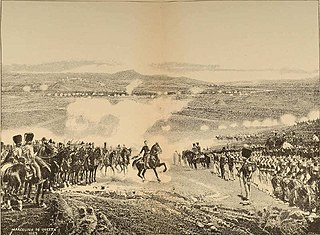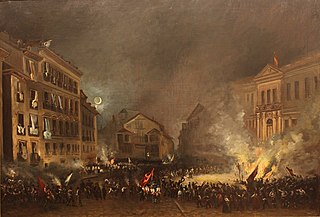
Isabella II was Queen of Spain from 1833 until her deposition in 1868. She is the only queen regnant in the history of unified Spain.

Maria Christina of the Two Sicilies was Queen of Spain from 1829 to 1833 and queen regent of the kingdom from 1833, when her daughter became queen at age two, to 1840. By virtue of her short marriage to King Ferdinand VII of Spain, she became a central character in Spanish history for nearly 50 years, thanks to introducing a bicameral model of government based on the Bourbon Restoration in France: the Spanish Royal Statute of 1834.

Juan Prim y Prats, 1st Count of Reus, 1st Marquis of los Castillejos, 1st Viscount of Bruch was a Spanish general and statesman who was briefly Prime Minister of Spain until his assassination.

Baldomero Fernández-Espartero y Álvarez de Toro was a Spanish marshal and statesman. He served as the Regent of the Realm, three times as Prime Minister and briefly as President of the Congress of Deputies. Throughout his life, he was endowed with a long list of titles such as Prince of Vergara, Duke of la Victoria, Count of Luchana, Viscount of Banderas and was also styled as "the Peacemaker".

The First Carlist War was a civil war in Spain from 1833 to 1840, the first of three Carlist Wars. It was fought between two factions over the succession to the throne and the nature of the Spanish monarchy: The conservative and devolutionist supporters of the late king's brother, Carlos de Borbón, became known as Carlists (carlistas), while the progressive and centralist supporters of the regent, Maria Christina, acting for Isabella II of Spain, were called Liberals (liberales), cristinos or isabelinos. It is considered by some authors to be the largest and most deadly civil war of the period.

Spain in the 19th century was a country in turmoil. Occupied by Napoleon from 1808 to 1814, a massively destructive "liberation war" ensued. Following the Spanish Constitution of 1812, Spain was divided between the 1812 constitution's liberal principles and the absolutism personified by the rule of Ferdinand VII, who repealed the 1812 Constitution for the first time in 1814, only to be forced to swear over the constitution again in 1820 after a liberal pronunciamiento, giving way to the brief Trienio Liberal (1820–1823).

The Glorious Revolution took place in Spain in 1868, resulting in the deposition of Queen Isabella II. The success of the revolution marked the beginning of the Sexenio Democrático with the installment of a provisional government.

Agustín Argüelles was a Spanish liberal politician. He served as the 81st and 94th president of the Congress of Deputies.
The Episodios Nacionales are a collection of forty-six historical novels written by Benito Pérez Galdós between 1872 and 1912. They are divided into five series and they deal with Spanish history from roughly 1805 to 1880. They are fictional accounts which add characters invented by the author within historical events.

Juan Van Halen y Sartí was a Spanish military officer and Russian military officer of Flemish origin. After fighting for the losing side in the Peninsular War, he was forced to flee to Spain. Van Halen became a military adventurer throughout Europe and went on an 18-month tenure as a colonel in the Russian Caucasus Dragoon Regiment until his removal by Tsar Alexander I of Russia.

Manuel de Pando y Fernández de Pinedo, 6th Marquess of Miraflores, 4th Count of la Ventosa, GE was a Spanish noble and politician, who served two times as Prime Minister of Spain and held other important political office such as Minister of State and President of the Senate.
The Moderate Party or Moderate Liberal Party was one of the two Spanish political parties that contended for power during the reign of Isabel II. Like the opposing Progressive Party, it characterised itself as liberal and dynasticist; both parties supported Isabel against the claims of the Carlists.
The Liberal Union was a political party in Spain in the third quarter of the 19th century. It was founded by Leopoldo O'Donnell in 1858 with the intent of forging a compromise and taking a centrist position between the two forces that had hitherto dominated Spanish politics during the reign of Isabella II. On one side were the forces of conservative liberalism known as the doceañistas, arrayed around the Moderate Party. Among their leading figures were the queen mother Maria Christina of the Two Sicilies and General Ramón María Narváez. On the other were radical liberal exaltados or veinteañistas arrayed around the Progressive Party and the National Militia. Among their leading figures was General Baldomero Espartero. Both parties had fought on the same side in the Carlist Wars, but they had also at times fought against one another, and elements of the Moderate Party leaned toward absolute monarchy themselves. O'Donnell's intent was to bring together the non-absolutist Moderates and the less "exalted" (radical) Progressives and to occupy the political center. He first came forward with this program in September 1854 a few months after the end of the 10-year reign of the Moderates, but did not succeed in forming a party at that time.
In the history of Spain, the bienio progresista was the two-year period from July 1854 to July 1856, during which the Progressive Party attempted to reform the political system of the reign of Isabella II, which had been dominated by the Moderate Party since 1843 in the so-called década moderada. The Progressives were exaltados or veinteañistas, advocates of radical liberalism, in contrast to the conservative liberalism of the doceañistas or Moderates.
There were numerous political parties and factions in Isabelline Spain. Some of them are known by multiple names, and in many cases the lines between these were fluid over time, both in terms of individuals moving from one party or faction to another and in terms of parties or factions changing their stances. Many of these factions are subgroups of parties, and groupings sometimes overlapped. Many factions were based on little more than political clientelism.

The Ominous Decade is a term for the last ten years of the reign of King Ferdinand VII of Spain, dating from the abolition of the Spanish Constitution of 1812, on 1 October 1823, to his death on 29 September 1833.

The Spanish Revolution of 1854, also known by the name Vicalvarada, started with a confrontation between rebel troops under General Leopoldo O'Donnell, 1st Duke of Tetuan and government troops near the village of Vicálvaro.

The Reign of Isabella II of Spain has been seen as being essential to the modern history of Spain. Her reign spanned the death of Ferdinand VII of Spain in 1833 until the Spanish Glorious Revolution of 1868, which forced the Queen into exile and established a liberal state in Spain.
The Exaltados was the label given to the most left-wing or progressive political current of liberalism in nineteenth-century Spain. Associated with, and at times inspired by, French Jacobinism and republicanism, it corresponded to the political current known more generally as Radicalism.

Isabella II of Spain was barely three years of age when her father Ferdinand VII of Spain died on 29 September 1833. Her minority age was marked first by the regency of her mother Maria Christina of the Two Sicilles and then under General Baldomero Espartero, covering almost ten years of her reign, until 23 July 1843, when Isabella was declared to be of age.











